Acids And Bases
An Acid may be defined ns any substance which has sour taste and its aqueous solution turns blue litmus red.It reacts with Bases to form water and ionic compounds called salts.
A base may be defined ns any substance which has bitter taste and its aqueous solution turns red litmus blue. It reacts with acid to form water and salts.
Arrhenius Concept
The first conceptual theory of acid and bases were given by Arrhenius, also known as Arrhenius theory of Ionization. According to him, ah acid is a substance that dissociates to give hydrogen ions when dissolved in water. Tlius hydrogen chloride gas is an acid because when dissolved in water, it gives hydrogen ions.

A base is a substance that dissociates to give hydroxyl ions when dissolved in water. Thus NaOH is a base because when dissolved in water, it gives hydroxyl ion.
![]()
According to neutralisation reaction, these two ions (H+ and OH-) combine to form solvent (i.c. water) and a salt (NaCl). This can be refered by the following equation:
Read and Learn More Pharmaceutical Inorganic Chemistry Notes
![]()
Limitations
- It is limited only to aqueous solution and not on substance.
- The neutralisation of acids and bases in absence of solvent could not be explained.
- H could not explain the basic nature of substances e.g.NH3, or Na2Co3 which do not contain OH’ ions and acidic nature of substances e.g. Co2 or So2 which do not contain H’ ions.
Bronsted-Lowry Concept (Proton Transfer Theory)
In 1923, J.N. Bronsted (Danish chemist) and J.M. Lowry (British Chemist) independently and suprisingly suggested a more general defination of acids and bases which applies to aqueous as well as non-aqueous solution.
According to him,’111 aci(l any substance (molecular or ionic) which has a tendency to donate a proton to any other substance while a base is any substance (molecular or ionic) which has a tendency to accept a proton (119 from any other substance.
Acid – Proton donor, Base- Proton acceptor
Some example of acids arc as follows :

Some example of bases are as follows :

Conjugate Acid-Base Pairs
Such pairs of substance which can be formed from one another by the gain or loss of a proton are known as conjugate acid base pair.
Thus conjugate of an acid is the substance formed by the loss of proton while conjugate of a base is the substance formed by the gain of a proton.
Let us consider a reaction of acetic acid in water which may be represented as:-

It is evident that acetic acid donates a proton to water and thus acts as an acid. Water accepts a proton and therefore acts as a base. In the reverse reaction, hydronium ion (H30)
donates a proton to the acetate ion and therefore acts as an acid. The acetate ion accepts a proton and therefore behave as a base.
Limitations of Bronsted- Loivry Concept:
- There are a number of acid-base reactions in which no proton transfer takes place e.g.

Thus, it cannot be able to explain the reactions occuring in non-protonic solvents such as CoCl2, S02. - Bronsted-lowry concept lay emphasis on the proton-transfer. Although it is true that most common acids are protonic in nature, yet there are many which are not.
The Lewis Concept- The Electron Donor Acceptor System
In 1923, Lewis (an American Chemist) introduced another concept of acid and base along with the formation of a cordinate bond. [According to him, an acid may be defined as
any species (molecule, radical or ion that can accept an electron pair to form a coordinate bond while a base may be defined as any species (molecule, radical or ion) that can donate
an electron pair to form a coordinate bond].
The chemical reaction between lewis acid and base results in a product that is described as adduct.
For example :

Here, BF3 accepts one lone pair of e- and is therefore a lewis,acid while NH3 donates one lone pair of e~s and is therefore known as lewis base.
Several examples of lewis acid and base are:
Lewis Acid: Ag+, Fe3+
Lewis Base: NH3 H20,OH–,C1–,CN–,etc
Limitations
- An acid-base reaction should be a rapid reaction as it involve electrons. Therefore, however many lewis acid-base reactions which are slow.
- The relative strength of an acid and bases cannot be explained on the basis of lewis concept.
Buffer Solution
The solutions that are able to resist the change in pH values are termed as Buffer solutions. Buffer solution consists of a mixture of weak acid and its salt and weak base and its salt.
Buffer solutions are broadly classified into three categories :
1. Acidic Buffer Solution: The solution having a mixture of weak acid and its salt. For
example : Mixture of Acetic acid and Sodium acetate.
2. Basic Buffer Solution: The solution having a mixture of weak base and its salt.
For example: Mixture of ammonium hydroxide and ammonium chloride.
3. Neutral Buffer Solution: The solution having a mixture of weak acid and weak base.
For example: Mixture of acetic acid and ammonium hydroxide
Buffer Action
The property of buffer solution is to resist any change in its pH value, even when small amount of acid or base is added to it known as”Buffer action”.
Hydrogen Ion Concentration, pH, And pOH
Pure water is considered to ionise to a small degree as per the following equation :
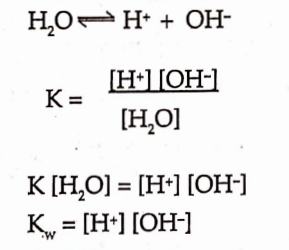
where Kw = Ion product Constant
The ion product constant (Kw) is expressed by involving only the concentration of ionic species on right-hand side of the reaction and has a constant value at 25°C of 1×10-14. It can be
represented as :
[H+] [OH–] = 1×10-14
In pure water, the concentration of both ions are equal each having the value of 1 x 10-7 M
[H+] [OH–] = 1×10-7
The hydrogen ion concentration is greater than hydroxide ion concentration when an acid or base is added to water. The value of hydrogen ion concentration is 10-7g ion/litre.
In Neutral solution [H+]= [OH–]
In Acid solution [H+]>[OH–]
In Alkaline solution [H+]< [OH–]
pH SCALE
Hydrogen ion concentration is usually expressed in terms of mole/litre or gram equivalent/litre. It is very unconvenient to write the expotential power of ten to the power
minus of particular figure. Therefore, Sorenson introduced a practical concept of expressing acidity i.e. pH scale.
The term pH is defined as the negative logarithm (to the base 10) of hydrogen ion concentration. It is represented by the expression :-
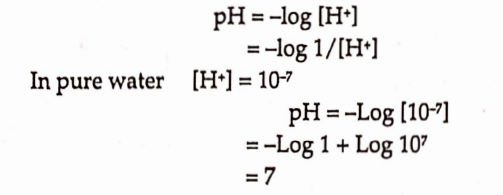
The pH scale covers from 0-14 of all the hydrogen ion concentrations. It can be measured by using the pH- meter.
If [H+] is high; the solution is acidic; pH<7 and if [H+] is low; the solution is basic or alkaline the pH founds to be less than 7 (pH>7)

pOH is defined as the negative logarithm of hydroxyl ion concentration.
pH = -log[OH–]
Relationship between pH and pOH
Ionic product of water is given by
Kw=[H3O+][OH–]
Taking log on both sides
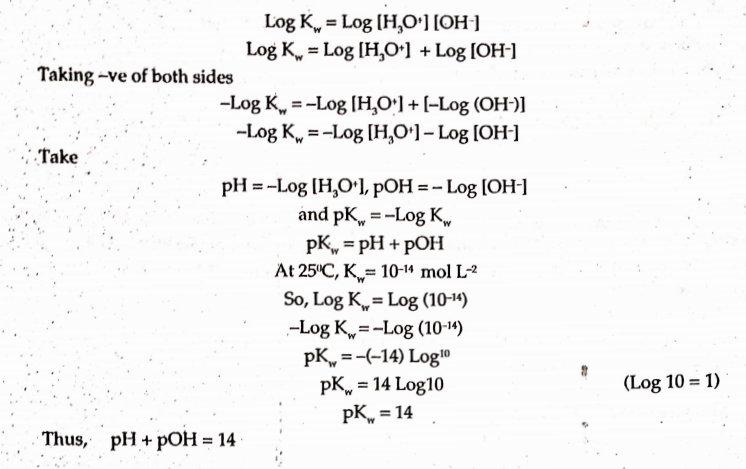
Relationship between pH and [H+] cone., moles/I
Numerical1: Calculate pH and pOH of 0.01N HC1.
Solution: HCl is a strong acid and it dissociate completely so
![Relationship between pH and [H+] cone., moles](https://cbseschoolnotes.com/wp-content/uploads/2024/01/Relationship-between-pH-and-H-cone.-moles-2.png)
![Relationship between pH and [H+] cone., moles](https://cbseschoolnotes.com/wp-content/uploads/2024/01/Relationship-between-pH-and-H-cone.-moles-1-1.png)
Henderson Hesselbach Equation
The hydrogen ion concentration obtainable from the dissociation of a weak acid HA, is given by the equation.
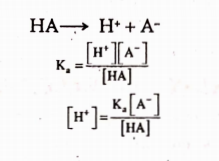
Taking logarithm on both sides :

This equation is known as the “Henderson-Hesselbach equadon”,it helps to calculate the pH of the buffer solution of known concentration.
Acid-Base Imbalance
The pH of normal blood ranges between 7.3-7.4. If the pH of the blood falls below 7.3, the condition is termed as Acidosis while if the pH of the blood is higher than 7.3, it is termed as Alkalosis. Both acidosis and alkalosis are primary disorders of bicarbonate. (HC03) ion cone.
Acid-base balance can also affect electrolytes (Na+, K+, Cl ) and hormones.
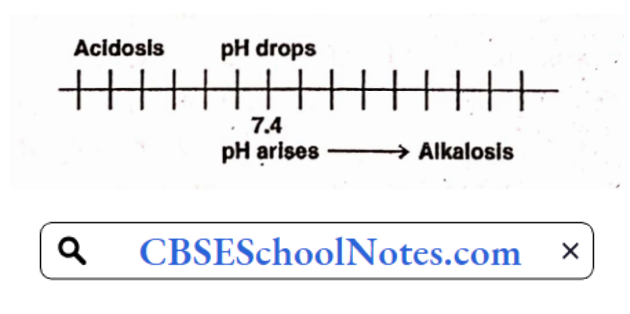
Buffer Capacity (P)
Quantitative measure of this resistance to pH changes is called buffer capacity. Buffer capacity can be defined as the number of moles of H+/OH- ions that must be added to one
liter of the buffer in order to decrease /increase the pH by one unit respectively.

Where [H+] = the hydrogen ion concentration of the buffer, (3 is the buffer capacity, [C] is buffer concentration.
From the above equation the buffer capacity is directly proportional to the buffer concentration.
Buffers In Pharmaceutical System
Buffer solutions are used frequently in pharmaceutical practice, particularly in the formulation of solid, semi solid, parenteral and ophthalmic preparations.
Solid dosage form:
Solid dosage forms such as tablets, capsules and powders buffers have been widely used for controlling the pH of the environment around the solid particles. This has practical application for the drugs that have dissolution rate limited absorption from unbuffered solutions.
One of the special applications of buffers is to reduce the gastric irritation caused by the acidic drugs. For example, magnesium carbonate, sodium bicarbonate and sodium citrate antacids are used for the purpose of reducing toxicity.
Semisolid Dosage Forms: Semisolid preparations such as ointments and creams undergo pH changes upon storage for a long time, resulting in its reduced stability.
Hence; buffers such as sodium citrate and citric acid or phosphoric acid/sodium phosphate are included in these preparations so as to maintain their stability.
Parenteral Products: Use of buffers is common in the parenteral products. Since the pH of blood is 7.4, these products are required to be adjusted to this pH. Change in pH to higher side (more than 10) may cause tissue necrosis while on lower side (below 3) it may cause pain at the site of action.
Commonly used buffers include phthalate, glutamate, citrate and acetate. The pH optimization is generally carried out to have better solubility, stability and reduced irritancy of the product.
Ophthalmic Products: Buffers are used in ophthalmic preparation is to prevent an increase in pH can affect both the stability and solubility of the drug. Buffering agents should be added in preparing on ophthalmic solution must be based on several considerations.
The buffer solutions are not specified in the Monographs of the Pharmacopoeia, but they are mentioned in the Pharmacopoeia under Appendix for solutions and reagents. There are two kinds of buffer solutions:
A. Standard buffer solutions B. Other buffer solutions
Standard Buffer solutions: These buffer solutions having standard pH. They are used for reference purposes in the measurement of pH and carrying out many pharmacopoeial tests which require maintenance of specified pH.
Standard buffer solutions of various pH range values between 1.2- 10.0 may be prepared by appropriate combinations of 0.2 M HC1, 0.2 M NaOH, described below in table:
Standard buffers with their pH range and quantities of ingredients

Other buffer solutions: There are large number of specific buffer solutions mentioned in the Appendix 13.1 of the Indian Pharmacopoeia 1996 with the direction of their preparation.
These buffer solutions are:
Acetate Buffer Solution pH 2.8
Acetate Buffer Solution pH 3.4
Acetate Buffer Solution pH 3.5
Acetate Buffer Solution pH 3.7
Acetate Buffer Solution pH 4.0
Acetate Buffer Solution pH 4.6
Acetate Buffer Solution pH 4.7
Acetate Buffer Solution pH 5.0
Acetate Buffer Solution pH 5.5
Acetate Buffer Solution pH 6.0
Ammonia buffer pH 9.5
Ammonia Buffer pH 10.0
Ammonia Buffer pH 10.9
Phosphate Buffer pH 2.0
Phosphate Buffer pH 2.5
Phosphate Buffer pH 3.6
Phosphate Buffer pH 4.0
Phosphate Buffer pH 4.9
Phosphate Buffer pH 5.0
Phosphate Buffer pH 5.5
Phosphate Buffer pH 6.5
Phosphate Buffer pH 6.8
Phosphate Buffer pH 7.0
Phosphate Buffer pH 7.5
Phosphate Buffer pH 8.0
Buffered Isotonic Solutions
Pharmaceutical solutions that are meant for application to delicate membranes of the body should be adjusted to same osmotic pressure as that of body fluids. Isotonic solutions cause no swelling or contraction.
Isotonic solutions cause no contraction or swelling of the tissues with which they come in contact and produce no discomfort when instilled in the nasal tract, eye, blood, or other body tissues.
There are three types of solutions in our body based on solute concentration:
1. Isotonic 2. Hypertonic 3. Hypotonic
Isotonic Solution: In this type of solution the concentration of solutes is the same both inside and outside of the cell. Example- a small quantity of blood is mixed with a solution containing 0.9 g of NaCl per 100 mL, the cells retain their normal size.
Hypertonic Solution: In this type of solutionthe concentration of solutes is greater outside the cell than inside it. Example- the red blood cells are suspended in a 2.0% NaCl solution, the water within the cells passes through the cell membrane in an attempt to dilute the surrounding salt solution.
This outward passage of water causes the cells to shrink and become wrinkled.
Hypotonic Solution: In this type of solutionhe concentration of solutes is greater inside the cell than outside of it. Example- the blood is mixed with 0.2% NaCl solution or with distilled water, water enters the blood cells, causing them to swell and finally burst
Isosmotic Solution Solutions having same osmolarity are known-as isosmotic solution.
Osmolarity: ft is a colligative property that measures the concentration of the solutes independently of their ability to cross a cell membrane.
Tonicity: ft js a property of a solution in reference to a particular membrane, and is equal lo the sum of the concentrations of the solutes which have the capacity to exert an osmotic force across that membrane. Tonicity, also, depends on solute permeability (permeant solutes do not affect tonicity; impermeant solutes do affect tonicity).
Methods used for the measurement of tonicity:
Many drugs and chemicals are used in pharmaceutical formulations. These substances contribute to the tonicity of the solution. Hence, methods are needed to verify the tonicity
and adjust isotonicity. There are two methods used to determine tonicity valve are:
1. Cryoscopic method 2. Hemolytic method
Cryoscopic method: Isotonicity values properties of the solutions. For this purpose, freezing point depression (ATf) property is most extensively used. The freezing point of water is Of 1C, and when any substance such as sodium chloride is added to it, the freezing point of water decreases.
The freezing point of depression of blood is -0.52DC. Hence, the freezing
point depression value of drug solution must be -0.52DC. This solution shows an osmotic pressure equal to the blood.
Hemolytic method: quantitative method developed by Hunter for the measurement of tonicity. Under this method the effect of various solutions on the drug is observed on the appearance of red blood cells suspended in the solutions, RBC’s are suspended in various solutions and the appearance of RBC’s is observed for shrinking, swelling, bursting, and wrinkling of the blood cells.
In hypotonic solutions, the oxyhemoglobin released is proportional to the number of cells haemolysed; in case of hypertonic solutions, the cells shrink and become wrinkled whereas in case of isotonic solutions the cells do not change their morphology. can be determined from the colligative
Methods Of Adjusting Tonicity
Several methods are used to adjust the isotonicity of pharmaceutical preparations. Isotonicity can be calculated from the colligative properties of drug solutions. If solutions injected or introduced in to nose and eyes, these are to be made isotonic in order to avoid haemolysis of RBC’s and to avoid pain and discomfort.
The amount of adjusting agents to be added is easy to determine by using the appropriate calculations based on colligative properties of solutions. It helps to are overcome the side effects caused from administering solutions which contain adjusting agents more or less than isotonic solutions. The methods are divided into three classes.
In the class I methods’ sodium chloride or some other substance is added to the solution of the drug to lower the freezing point of the solution to -0.52°C and thus make it isotonic with body fluids. Under this class are included ihesodium chloride equivalent method and cryoscopic method.
In the class II methods, water is added to the drug in a sufficient amount to form an isotonic solution. The preparation is then brought to its final volume with an isotonic or a buffered isotonic dilution solution. Included in this class are theMzite-Vincent method.
In class III method L iso and Freezing point depression values for number of drugs are estimated theoretically from the molecular weight of the drug and can be used to calculate the amount of adjusting substance to be added in order to make the solution isotonic
Class I Method:
Sodium chloride equivalent method:
It is also called tonicity equivalent method. This method is used to adjust the tonicity of pharmaceutical solutions. Sodium chloride equivalent (E) of a drug is the amount of sodium chloride that is equivalent to1 gm of the drug.
The percent of sodium chloride required for adjusting the isotonidty can be calculated using the following equation.
PSA = 0.9- (PSM x E of medicament) Where,
PSA = Percent of sodium chloride for adjustment of isotonidty
PSM = Percent strength of medicament
Above equation is used to calculate the amount of adjusting substance (NaCl) required for making the solution isotonic. It is valid for 100 ml solution.
Example:- Calculate the gram of sodium chloride needed to make 50 ml of a 3% isotonic physostigmine salicylate solution using sodium chloride method.
Solution:
E value of physostigmine salicylate = 0.16
PSM =3.0 % Volume of preparation required = 50 ml
For equation
PSA = 0.9- (PSM x E of medicament)
= 0.9- (3.0 x 0.16) = 0.9 – 0.32 = 0.42 %
The above strength is valid for 100 ml since is expressed in percent. It should be prepared from 50 ml of solution
For 100 ml of solution, sodium chloride required = 0.42
For 50 ml of solution, sodium chloride required =?
50 x 0.42/100 = 21/100 =0.21 g of sodium chloride
Cryoscopic method:
According to this method, the quantity of each substance required for an isotonic solution can be calculated from the freezing point depression (AT/ ) values.
A solution which is isotonic with blood has a of 0.52DC. Therefore, the freezing point of drug solution must be adjusted to this valve.
For example, the drug concentration in 100ml solution is a gram, then the weight (in grams) of adjusting substance can be calculated as:
ΔTf/ (for drug solution) = ax
ΔTf/ of1% drug solution = x
If w be in grams of the adjusting substance to be added to 100 Ml of drug solution to make it isotonic then:
ΔT/ for adjusting solution = w x ΔT/ of 1% adjusting substance
= wxb
For making a solution isotonic:
x + wb = 0.52
w = 0.52- x/b
or
If sodium chloride is used as adjusting substance whose ATf of solution is 0.58°C (0.576°C), then
W = 0.52-x/0.58
Sodium chloride equivalent (E) and Freezing point depression values of some drugs added substances:
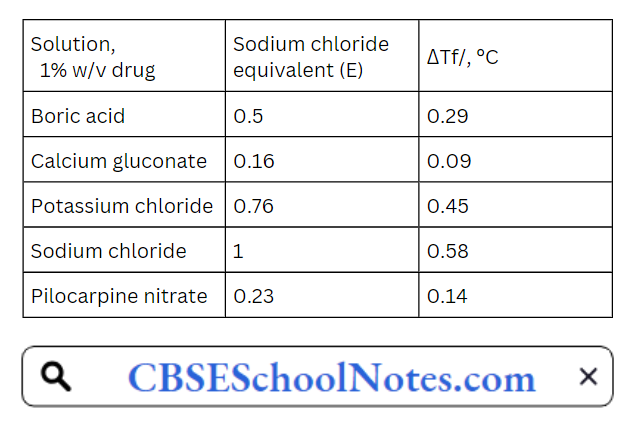
Class-II Method
White-Vincent method:
This method involves the addition of water to the drugs to make an isotonic solution, followed by the addition of an isotonic or isotonic-buffered diluting vehicle to bring the solution to the final volume.
Stimulated by the need to adjust the pH in addition to the tonicity of ophthalmic solutions. White -Vincent developed a simplified equation for calculating the volume V (mis) of osmotic solution prepared by mixing drug with water.
V = wxEx 111.1
Where, w = weight of the drug (gm)
E = sodium chloride equivalent
Class-lll Method
The L ISO Method: According to this method the freezing point depression equation is used to calculate the amount of the isotonicity-adjusting substance that must be added to hypotonic solution of drug to bring to tonicity.
As the freezing than those calculated by the point depression for solutions of electrolytes are equation, ΔTf/= Kfm, a new constant L iso is introduced to account for this deviation.
The equation then becomes
ΔTf = L iso C
The following equation helps to calculate the E Nacl value from L iso value of the substances. The ΔTf of 1 g of drug per 100ml of solution is equal to L iso C.
Therefore,
ΔT/ = L iso l(gm)/M
= L iso/M
Where, M is molecular weight of solute and M and L iso value of Nacl is 3.4,
ΔT/= 3.4 x E/58.45
L ISO Values of the Tonicity adjusting substances
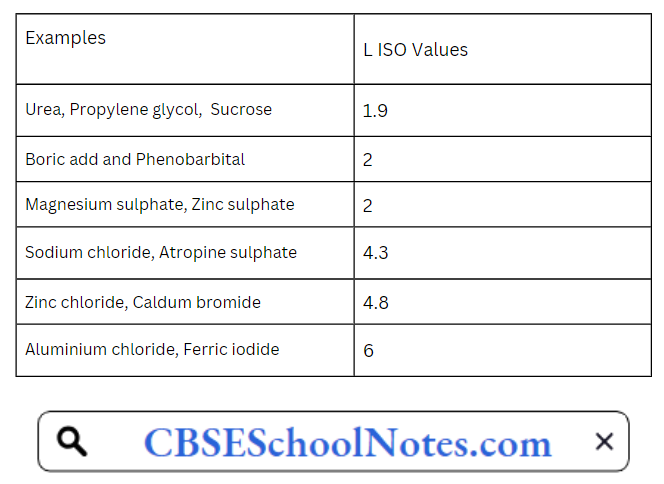
Acids Bases And Buffer Very Short Answer Questions
Question.1. Define the following terms :
- Acid
- Base
- pH
- Buffer solution
Answer.
- Acid is a substance which has sour taste and it turns blue litmus red.
- Base is a substance which has bitter taste and it turns red litmus blue.
- pH is defined as the negative logarithm (to the base 10) of hydrogen ion concentration. It is expressed as:
pH = -log10[H+] - Buffer solutions are defined as those solutions which are able to resist the change in pH value.
Question 2. What are conjugate acid-base pairs?
Answer. Conjugate acid-base pairs are defined as such pairs of substances which can be formed from one another by the gain or loss of proton.
Question 3. What is the pharmaceutical use of calcium hydroxide?
Answer. Calcium hydroxide is used as a substitute for baking soda. It is also used for processing water for alcoholic beverages eg. Soft drinks.
Question .4. What is Acidosis?
Answer. Acidosis is defined as those condition in which the pH of the blood falls below 7.3.
Question 5. How many type of buffer solutions are there? Explain.
Answer. There are many types of Buffer solution :
- Acidic Buffer
- Basic Buffer
Acidic Buffer Solution: The solution having a mixture of weak acid and its salt.
For example: Mixture of Acetic acid and Sodium Acetate.
Basic Buffer Solution: The solution having a mixture of weak base and its salts.
For example: Mixture of ammonium hydroxide and ammonium chloride.
Question.6. Write down the preparation and uses of boric acid?
Answer. Boric acid is prepared by reacting hydrochloric or sulphuric acid with the native borax to produce orthoboric acid.

Boric add is for used in dusting powders,lotions and creams.It can be used as an anti spectic for minor burns or cuts and is sometimes used in dressings or shaves.
Question.7.comment on the statement that “All Arrhenius acids are also bronsted acid but all arrhenius bass are not bronsted bases”.
Answer. According to Arrhenius concept, an acid is a substance that dissociated completely to give hydrogen ions when dissolved in water same is with lewis acid which is a proton-donor while a base is a substance that dissociates to give hydroxyl ions when dissolved in water
Question.8 Which concept denis with “Eleclron-Donor-Acceptor System”?
Answer. Lewis Concept deals with the electron donor -acceptor system.
Question 9 Write a balanced equation for a neutralization of acid and base?
Answer. According to neutralisation reaction, these two ions (H+ and OH”) combine to form solvent (i.e. water ) and a salt ( NaCl). these can be represented by the following equation:-
HCL (acid) + NaOH (base)———-> NaCl (salt)+ H2O (water)
Acids Bases And Buffer Short Answer Questions
Question 1. How are acid and bases defined in terms of :
- Arrhenius concept
- Lewis concept? Give suitable examples.
Answer:
1) Acording to Arrhenius concept, an acid is a substance that dissociates to give . hydrogen ions when dissolved in water while a base is a substance that dissociates to give hydroxyl ions when dissolved in water.

2) Lewis acid may be defined as any species (molecule, radical or ion) that can accept an electron pair to form a coordinate bond while a base may be defined as any species ( molecule, radical or ion) that can donate an electron pair to form a coordinate bond.
Question 2. What do you understand by the term “conjugated acid base pair”? Show that “a strong acid has a weak conjugate base and a weak acid has a strong conjugate base”.
Answer:
Conjugate acid- base pairs are the pairs of substances which can be formed from one another by the gain or loss of a proton.Thus conjugate of an acid is the substance which can be formed by the loss of a proton while conjugate of a base is the substance which can be formed by the gain of a proton.
Let us consider a reaction of acetic acid in water which may be represented as:-

Acetic acid donate a proton to water and thus acts as an acid. Water accepts a proton and therefore acts as an base. In the reverse reaction, hydronium ion donate a proton to the acetate ion and therefore acts an acid. The acetate ion accepts a proton and therefore behaves as an base.
Question 3. What is Buffer Solution? How many types of Buffer solutions are there? Explain.
Answer:
Buffer solutions are defined as those solutions which are able to resist the change in pH value. Buffer solution consists of a mixture of weak acid and its weak base and its salt.
There are many types of Buffer solution :
- Acidic Buffer
- Basic Buffer
- Neutral Buffer
Acidic Buffer Solution: The solution having a mixture of weak acid and its salt. For example: Mixture of Acetic acid and Sodium Acetate.
Basic Buffer Solution: The solution having a mixture of weak base and its salts. For example: Mixture of ammonium hydroxide and ammonium chloride.
Neutral Buffer Solution: The solution having a mixture of weak acid and weak base. Forexample: Mixture of acetic acid and ammonium hydroxide.
Question 4. What is Buffer capacity? Explain the mechanism of Buffer action?
Answer:
The property of buffer solution to resist any change in its pH value, even when small amount of acid or base is added to it is known as “Buffer action”.
Question 5.Describe method of preparation, properties and uses of calcium hydroxide?
Answer: Calcium hydroxide
Molecular formula=Ca(OH)2 Molecular Weight =74.09
Calcium hydroxide is prepared by spraying water on to quicklime which is itself prepared by heating limestone. The lumps of quicklime break into powder and heat is evolved
CaCO3 ——–>CaO+CO2
It occurs as odourless. It is having bitter saline taste.
It is internally used as antacid. It is used in dentistry
Acids Bases And Buffer Fill In The Blanks
1. Buffer solutions are those which resist the change in …….
Answer: pH
2. Measurement of pH can be done using…….
Answer: pH-meter
3. pH of blood in human body is about…….
Answer: 73-7.4
4. Add turns…..litmus……
Answer: Blue, red
5. Base has ……..taste.
Answer: Bitter
6. According to Bronsted lowry concept, an acid is…… while base is……
Answer: Proton-acceptor, proton donor
7. Soft acids have…….size while hard base have……size.
Answer: Smaller, larger
8. The value of hydrogen ion cone, is……..while
Answer: 1.0×10-7
9.If [H+] is High; the solution is ————–while If [H+] is low; the solution is…….
Answer: Acidic, basic
10………is also known as slaked lime.
Answer: Calcium hydroxide
Acids Bases And Buffer Multiple Choice Questions
Question 1. Which of the following is not a properties of acid?
- Taste sour
- Turn blue litmus red
- React with base to form water
- Feel slippery on the skin
Answer: Feel slippery on the skin
Question 2. Which of the following is not a property of base?
- Taste bitter
- Turn blue litmus red
- React with salts to form acid
- Feel slippery on the skin
Answer: React with salts to form acid
Question.3.In general when an acid and a base are mixed
- A new add and a salt are formed
- A new base and a salt are formed
- No reaction occurs
- A salt and water are formed
Answer: A salt and water are formed
Question.4.Which of the following equations best represents what happens when hydrogen bromide dissolves in water
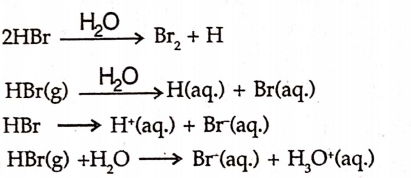
Answer:
![]()
Question.5.What is the pH of a solution that has a hydrogen ion cope, of lxJOÿM?
- 4
- 6
- 9
- 3
Answer: 3
Question.6.Which of the following pair is a conjugate acid-base pair?
- CH3COOH and OH-
- HCN and CN-
- HCN and OH-
- HC1 and OH-
Answer: HCN and CN-
Question 7. Which buffer is used for maintaing acid-base balance in the blood?
- Carbonic acid – bicarbonate ion
- Acetic acid and sodium acetate
- Ammonium hydroxide-ammonium chloride
- Formic acid-sodium formate
Answer: Carbonic acid – bicarbonate ion
Question.8. Sodium hydroxide is commonly known as
- Slaked lime
- Spirit of salt
- Caustic soda
- Quick lime
Answer: Spirit of salt
Question.9. If the pH of the blood falls below 7.3, the condition is termed as:-
- Acidosis
- Alkalosis
- Neutral
- None of the above
Answer: Acidosis
Question.10. Strong ammonium hydroxide is prepared by
- Salvay process
- Merck process
- Haber’s process
- Ammonia soda
Answer: Merck process
